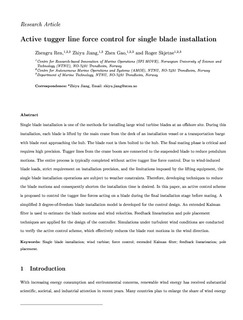Active tugger line force control for single blade installation
Journal article
Submitted version
Permanent lenke
http://hdl.handle.net/11250/2563595Utgivelsesdato
2018Metadata
Vis full innførselSamlinger
- Institutt for marin teknikk [3432]
- Publikasjoner fra CRIStin - NTNU [38127]
Originalversjon
10.1002/we.2258Sammendrag
Single blade installation is one of the methods for installing large wind turbine blades at an offshore site. During this installation, each blade is lifted by the main crane from the deck of an installation vessel or a transportation barge with blade root approaching the hub. The blade root is then bolted to the hub. The final mating phase is critical and requires high precision. Tugger lines from the crane boom are connected to the suspended blade to reduce pendulum motions. The entire process is typically completed without active tugger line force control. Due to wind‐induced blade loads, strict requirement on installation precision, and the limitations imposed by the lifting equipment, the single blade installation operations are subject to weather constraints. Therefore, developing techniques to reduce the blade motions and consequently shorten the installation time is desired. In this paper, an active control scheme is proposed to control the tugger line forces acting on a blade during the final installation stage before mating. A simplified three degree‐of‐freedom blade installation model is developed for the control design. An extended Kalman filter is used to estimate the blade motions and wind velocities. Feedback linearization and pole placement techniques are applied for the design of the controller. Simulations under turbulent wind conditions are conducted to verify the active control scheme, which effectively reduces the blade root motions in the wind direction.
